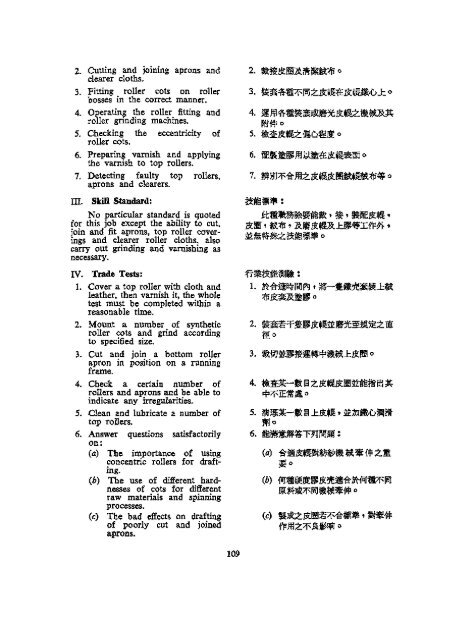m - HKU Libraries
m - HKU Libraries
m - HKU Libraries
You also want an ePaper? Increase the reach of your titles
YUMPU automatically turns print PDFs into web optimized ePapers that Google loves.
2. Cutting and joining aprons and<br />
clearer cloths.<br />
3. Fitting roller cots on roller<br />
bosses in the correct manner.<br />
4. Operating the roller fitting and<br />
roller grinding machines.<br />
5. Checking the eccentricity of<br />
roller cots.<br />
6. Preparing varnish and applying<br />
the varnish to top rollers.<br />
7. Detecting faulty top rollers,<br />
aprons and clearers.<br />
III. Skill Standard:<br />
No particular standard is quoted<br />
for this job except the ability to cut,<br />
join and fit aprons, top roller coverings<br />
and clearer roller cloths, also<br />
carry out grinding and varnishing as<br />
necessary.<br />
IV. Trade Tests:<br />
1. Cover a top roller with cloth and<br />
leather, then varnish it, the whole<br />
test must be completed within a<br />
reasonable time.<br />
2. Mount a number of synthetic<br />
roller cots and grind according<br />
to specified size.<br />
3. Cut and join a bottom roller<br />
apron in position on a running<br />
frame.<br />
4. Check a certain number of<br />
rollers and aprons and be able to<br />
indicate any irregularities.<br />
5. Clean and lubricate a number of<br />
top rollers.<br />
6. Answer questions satisfactorily<br />
on:<br />
(a) The importance of using<br />
concentric rollers for drafting.<br />
(6) The use of different hardnesses<br />
of cots for different<br />
raw materials and spinning<br />
processes.<br />
(c) The bad effects on drafting<br />
of poorly cut and joined<br />
aprons.<br />
109

















